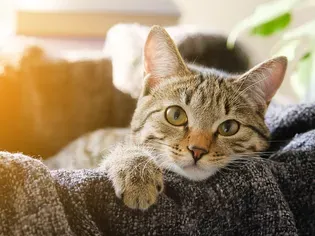Feline Calicivirus (FCV) In Cats
Updated on 04/26/24

Understanding Feline Calicivirus (FCV): A Comprehensive Guide for Cat Owners
Feline calicivirus (FCV) is a highly contagious viral infection that affects cats of all ages. It's characterized by a wide range of symptoms, from mild respiratory issues to severe pneumonia and systemic disease. As a responsible cat owner, it's essential to understand this virus and its potential impact on your feline friend. This comprehensive guide will provide you with all the information you need to prevent, recognize, and manage FCV in your cat.
Transmission and Spread of FCV
FCV is primarily spread through close contact with infected cats or their respiratory secretions, such as saliva, nasal discharge, or feces. It can also be transmitted indirectly through contaminated food, water bowls, litter boxes, or grooming tools. The virus can survive in the environment for several days, making it highly contagious.
Clinical Signs of FCV Infection
The clinical signs of FCV infection can vary significantly depending on the strain of the virus and the cat's immune status. Symptoms typically develop within 2-10 days after exposure to the virus and can include:
* Respiratory symptoms: Sneezing, nasal discharge, coughing, difficulty breathing, congestion
* Oral symptoms: Ulcers or sores on the tongue, palate, or gums, excessive salivation
* Ocular symptoms: Conjunctivitis, discharge from the eyes
* Gastrointestinal symptoms: Vomiting, diarrhea
* Systemic symptoms: Fever, lethargy, depression
Diagnosis and Treatment of FCV
Diagnosing FCV can be challenging, as the clinical signs overlap with other feline respiratory infections. Your veterinarian will perform a thorough physical examination and collect a sample of the cat's saliva, nasal discharge, or feces for laboratory testing.
Treatment for FCV is supportive and aims to alleviate the symptoms and prevent complications. There is no specific antiviral medication for FCV, but the following measures may be recommended:
* Antibiotics: To treat secondary bacterial infections
* Anti-inflammatory medications: To reduce inflammation and pain
* Expectorants: To aid in the removal of mucus from the respiratory tract
* Fluids: To prevent dehydration
* Nutritional support: To ensure adequate caloric intake
Prevention of FCV Infection
Vaccination is the most effective way to prevent FCV infection in cats. The FCV vaccine is typically included in the core feline vaccination protocol and is administered in a series of injections. Kittens should receive their first vaccination at around 8-12 weeks of age, followed by regular boosters as recommended by your veterinarian.
Other preventive measures include:
* Isolating infected cats: Keep infected cats away from other cats to prevent the spread of the virus.
* Practicing good hygiene: Wash your hands frequently, especially after handling infected cats or their belongings.
* Disinfecting the environment: Clean and disinfect surfaces that may have come into contact with an infected cat.
* Avoiding high-risk environments: Keep your cat away from areas where there are unvaccinated or potentially sick cats.
Long-Term Effects of FCV Infection
Most cats with FCV infection recover fully with supportive treatment. However, some cats may develop chronic respiratory or oral health problems. In rare cases, FCV can lead to severe systemic disease and even death if not treated promptly.
Case Studies
To illustrate the impact of FCV infection in cats, let's consider the following case studies:
Example 1:
* 6-month-old kitten with mild upper respiratory symptoms (sneezing, nasal discharge)
* Diagnosed with FCV infection after laboratory testing
* Treated with antibiotics and anti-inflammatory medications
* Recovered fully within a week
Example 2:
* 10-year-old cat with chronic respiratory problems and oral ulcers
* Had a history of recurrent FCV infections
* Developed severe pneumonia requiring hospitalization
* Successfully treated with antibiotics, fluids, and nutritional support
* Managed with long-term antibiotics and respiratory medications
These case studies highlight the variable nature of FCV infection and the importance of early diagnosis and appropriate treatment to minimize the severity and long-term effects of the disease.
Conclusion
Feline calicivirus is a common and potentially serious viral infection in cats. By understanding the transmission, clinical signs, diagnosis, treatment, and prevention of FCV, you can help protect your cat and ensure its long-term health and well-being. Regular vaccination, good hygiene practices, and prompt veterinary care are essential for managing FCV infection in cats.
Explore More Pets

Cat Behavior Problems
How to Stop Aggression in Kittens

Long-Haired Cat Breeds
Siberian Cat: Breed Profile, Characteristics, & Care

Cat Behavior Problems
How to Stop Kittens From Scratching and Biting

Long-Haired Cat Breeds
Turkish Angora: Cat Breed Profile, Characteristics & Care

Basic Training
How to Socialize Your Kitten

Short-Haired Cat Breeds
Cute Pictures & Facts About Calico Cats & Kittens

Litter Box Training
Training Your Kitten to Use the Litter Box

Long-Haired Cat Breeds
10 Fun Facts About White Cats